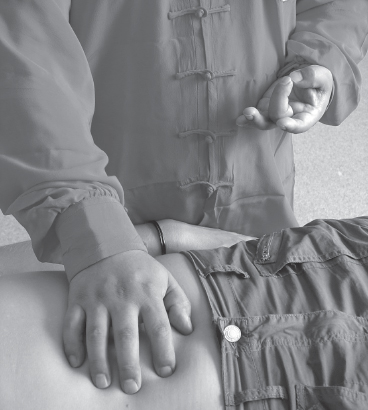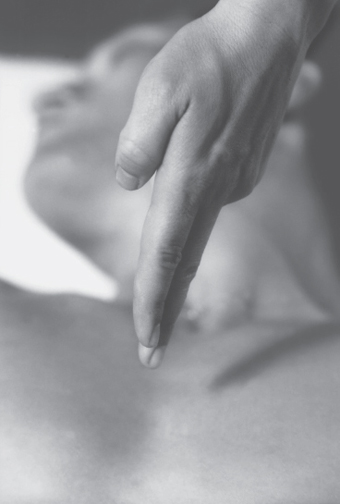4 Options and Methods in Fertility Treatment No discussion of the modes of treatment in Chinese medicine would be complete without mentioning qi gong as a therapeutic method. In spite of the fact that these techniques are used rather sparingly in clinic, qi gong offers an additional spectrum of treatment options. This method is still often neglected even in traditional Chinese hospitals. Just like acupuncture, qi gong has taken a long time to be acknowledged in the West. The two methods share certain characteristics, such as the treatment of the qi flow. Nevertheless, the practitioner works with needles in acupuncture, but with the bare hands in the diagnosis and treatment with qi gong. Often, the patient’s body is not touched at all. As a consequence of the enthusiasm for and rediscovery of the old medical teachings, many hospitals and universities in China have carried out research projects and studies on qi gong. This has resulted in a growing acceptance, even beyond practicing patients and practitioners. Because qi gong is also valued and demanded in China by Western practitioners who are studying there, simple methods are taught in the hospitals. Some physicians cultivate their own qi with a series of exercises from qi gong. Qi gong is an old Chinese method for cultivating the body’s own qi, the “vital energy.” It requires regular practice times. Gong means “to work hard on something,” “to apply real effort to acquire a skill.” Tsu Kuo Shih offers the following definition in his book Qi Gong Therapy: “Qi gong is the art of exercising jing (essence), qi (energy), and shen (spirit). The heart of qi gong is the training of yi (imagination) and qi (vital energy). The main goal of these exercises is to regulate the internal functions of the human body. We achieve this in qi gong by developing our power of imagination and breathing techniques, by guiding the inner qi towards realization, and by moving and strengthening the inner qi. The inner qi is the body’s very own original qi. Therefore, we can achieve self-regulation and self-control of the internal organs by means of qi gong.”5 As a therapeutic principle, its effects are explained by the following factors: In qi gong therapy, we invariably encounter the concept of the “three treasures”—jing, qi, and shen. Jing—essence—refers to the foundation of vital activities, which is supplied by the kidney. We distinguish between: The term “essence” indicates that by transforming and refining an undifferentiated substance something precious has been created that must be cultivated and protected. The character jing can be translated as “something produced by distillation.” The energy form jing is stored in the kidneys. Because of its “fluid” nature, it circulates throughout the entire body. Sperm and ovum are a form of this precious subtle essence. The man’s jing can be squandered by excesses of any kind, but especially by sexual debauchery with repeated ejaculations. In women, frequent births, miscarriages, and intensive hormone therapy can lead to a loss of jing. In addition, the monthly build-up of the endometrium for the implantation of the ovum and the subsequent bleeding associated with the shedding of the endometrium consume jing. Jing is the basis for growth, reproduction, and development. Qi—vital energy—includes all forms of energy, from the air that we breathe to the life-sustaining energy that animates our body. Qi is the life force that guarantees all emotional, mental, and bodily functions throughout our life. It goes hand in hand with breathing and finally leaves the body with our last breath. Health and illness depend on the strength and regular circulation of qi. Shen—spirit—comprises a wealth of human characteristics such as charisma, consciousness, spirit, and personality. We can summarize shen as the spiritual, intellectual, mental, and especially communicative capacities of the person. Master Li Jiacheng is a qi gong physician in Xi’an. He treats patients with qi gong and teaches them a qi gong method for self-practice. He recommends different exercises that can be utilized in infertility. The main exercise aims at strengthening the lower dan tian (dan tian qi gong). In addition, specific exercises are taught for men (nan dan gong—men’s qi gong) and for women (nü dan gong—women’s qi gong) respectively. In kidney vacuity, a kidney-strengthening qi gong should be practiced. In addition, he also recommends a visualization technique for fertility through the “third eye” (see below). The technique for “retaining jing (ejaculate)” is only recommended for men who have been practicing qi gong for a long time or are familiar with Daoist practices. Nevertheless, it is desirable to have more frequent sex with ejaculation during the time of ovulation and to be more reserved concerning ejaculation at other times. If an exercise program has been set up but pregnancy has still not occurred after 2 years, abstinence should be practiced for 3 months in order to prevent the loss of additional jing. If the general constitution is very weak, patients should always be given Chinese medicinals for supplementation as well. Furthermore, a weakened constitution calls for a therapy according to the following treatment plan: These recommendations should be modified for Western circumstances: daily acupuncture treatment is widely accepted in China, but would certainly be much less acceptable here. Attend qi gong classes daily for 1 week, then consult the teacher once a month. In the meantime, practice daily. Daily qi gong treatment and qi gong exercises for 1 week; then continue to practice qi gong exercises for 3 months. During this time, no sexual excess, be conservative with ejaculation (jing), and pay particular attention to the time of ovulation. Daily qi gong treatment and practice for 1 month. Afterwards, continue with the exercises for 6 months and do not have sex during this time. Then return to the easier variation. Pay attention to the time of ovulation. One method of application is qi gong treatment (wai qi treatment) by a qi gong physician or qi gong practitioner. The practitioner uses concentrated qi to carry out a treatment through touch (qi gong massage, qi gong acupressure) or without touch (fa qi—emitting energy) (Figs. 9.1). Fig. 9.1 Qi gong massage on the abdomen. This treatment is used primarily in the treatment of chronic disorders, for strengthening in conditions of weakness (also of individual organ systems) or for harmonizing the circulation of qi (e. g., in emotional imbalance). While the practice of qi gong is already widespread in the West, the method of external qi gong treatment by a physician or practitioner has still not received much attention. Working with external qi requires long practice, a good teacher, and a great feeling of responsibility. In “external qi gong treatment” (wai qi fa), the practitioner first makes the diagnosis and establishes a treatment principle. The treatment of female and male patients is performed with the patient either sitting or lying. The physician or practitioner emits qi (fa qi). This occurs without touch, from a certain distance. As in the other treatment methods of TCM, the treatment stimulus can be determined discriminately. The two main treatment principles are bu fa—strengthening (supplementing/concentrating)—and xie fa—draining (discharging/dispersing)—in repletion states. The principle bu fa is applied in states of vacuity (exhaustion) and the principle xie fa in states of repletion (Table 9.1).
9 Qi Gong
Annette Jonas
Qi Gong and its Medical Applications
The Effects of Qi Gong
The Three Treasures (San Bao)
Jing
Qi
Shen
Qi Gong for Fertility Treatment in China
The Exercises
Conserving Jing
Exercise and Therapy Plan
Concept 1—Easy Variation
Concept 2—Moderately Difficult Variation
Concept 3—Difficult Variation
Qi Gong as Treatment by the Practitioner

| Principle | Action | Indication |
| Bu fa | Supplementing/concentrating | Filling yin/yang, in vacuity |
| Xie fa | Draining/dispersing | Sedating, distributing, dispersing, in repletion |
| He fa | Harmonizing | Soothing method |
| Wen fa | Warming | Treatment of cold disorders |
| Tong fa | Promoting flow | Removing blockages of qi and blood |
| Han fa | Promoting sweating | For invading pathogenic factors, also drafts |
| San fa | Resolving and dispersing | Eliminating pain and swelling |
| Qing fa | Clearing (heat) | Cooling, freeing in fever |
Wai qi treatment is also used in the treatment of inoperable cancer conditions. In addition, it is commonly applied in emotional imbalance. A technique that is applied locally is wai fa qi with the sword finger (Figs. 9.2). It is applied on the forehead above the point yin tang to calm the spirit, or it can have a dispersing effect on compressed tissue.
Qi Gong as Self-treatment
The largest and most well-known aspect of qi gong, practiced by many people in and outside of China, consists of “methods for self-practice.” This refers to mostly simple exercises that are demonstrated by a teacher and then again and again repeated by the student over a longer period of time. There are general exercises that are widely disseminated as yang sheng (method for cultivating health), such as the “eight brocades” or the “18 movements tai ji qi gong.” Special exercises are often taught in clinics for certain disorders or symptoms, such as “lung qi gong” or “cancer qi gong.” Such special exercises for the treatment of diseases are called medical qi gong. In all cases, it is important to practice continuously over an extended period of time to achieve the desired effect.
The Dan Tian Exercise
Master Li Jiacheng regards the practice of concentrating on the “lower dan tian” (dan “cinnabar,” tian “field”) as the most basic exercise for all qi gong methods. Before starting to practice other complicated qi gong exercises, practitioners should first be able to concentrate their qi.

Stay updated, free articles. Join our Telegram channel

Full access? Get Clinical Tree



